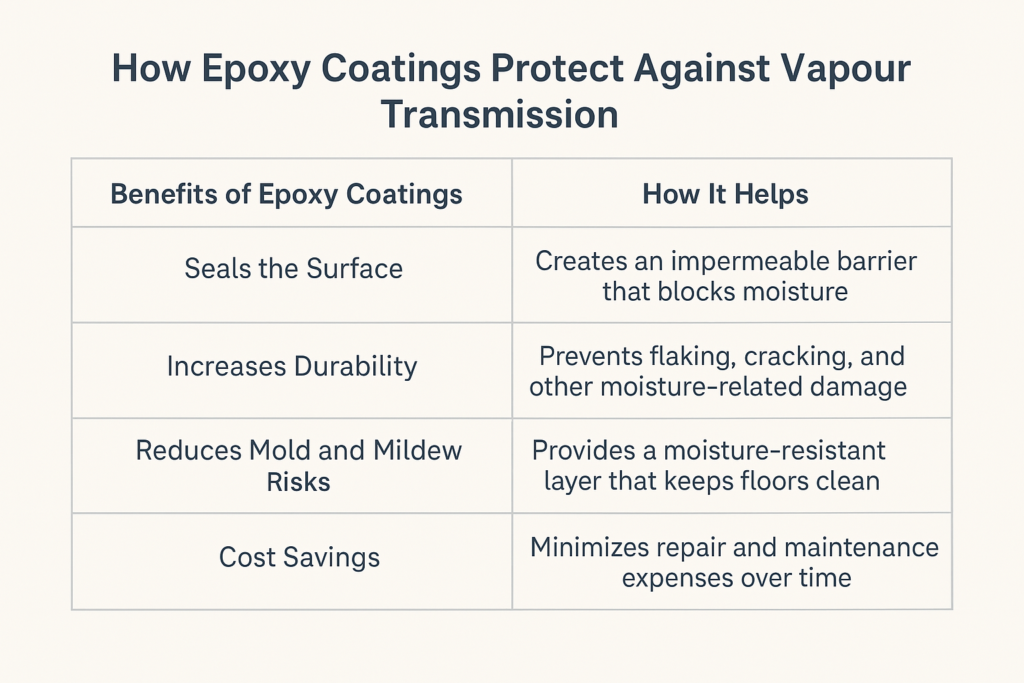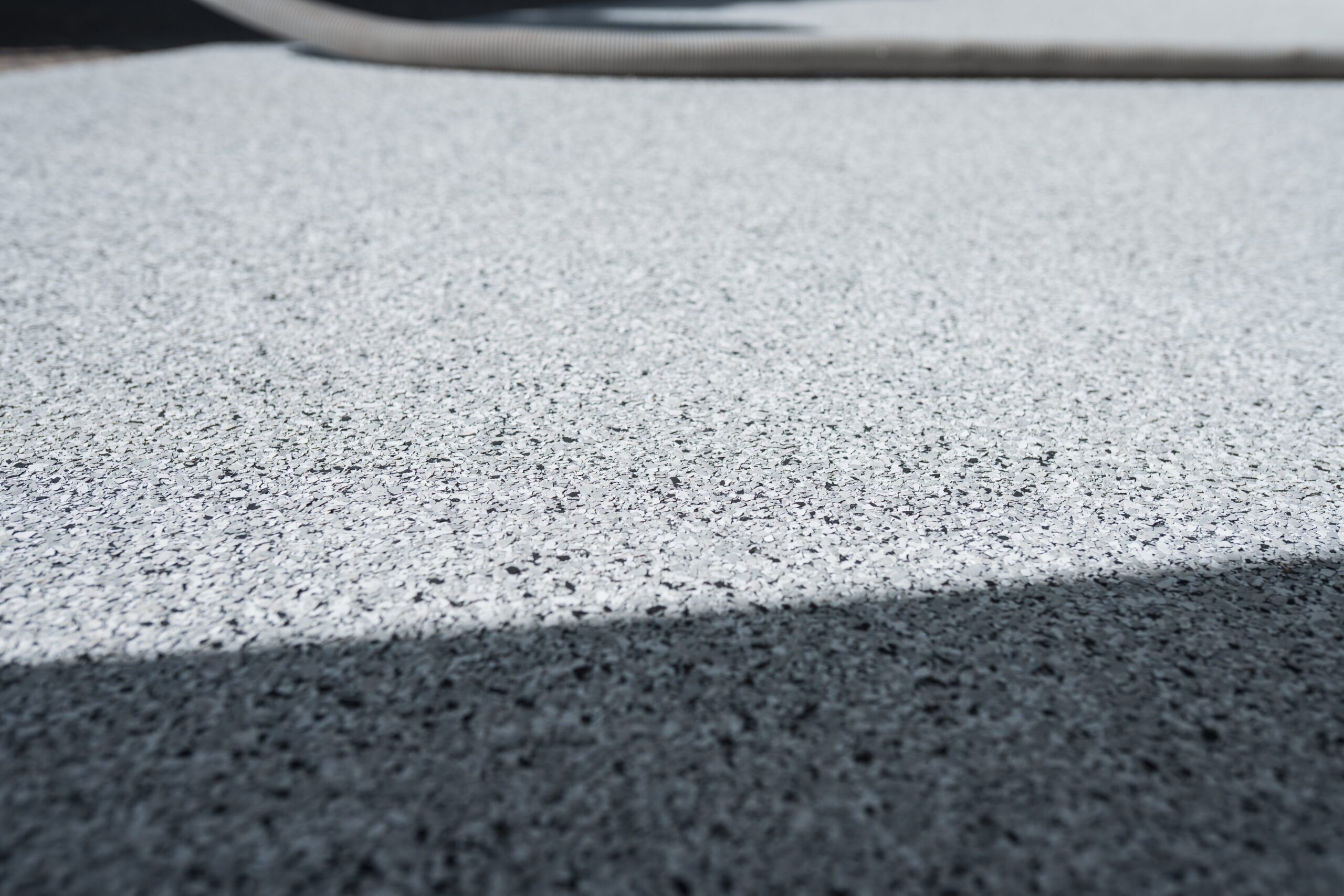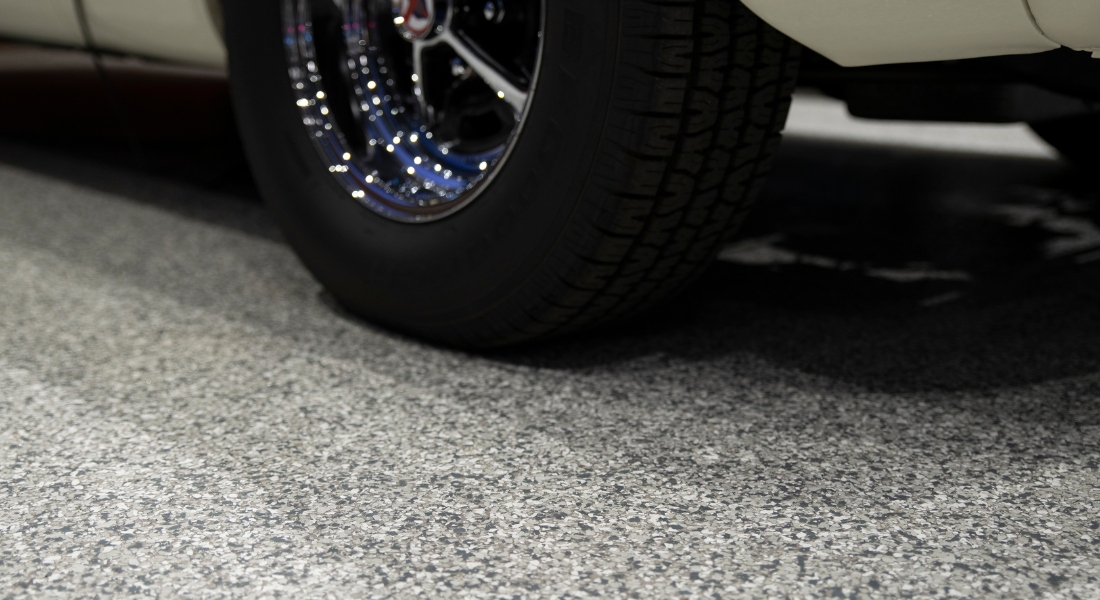Concrete is a strong, durable material, but it’s not invincible. One of the biggest threats to the long-term health of concrete floors is moisture transmission, which can cause significant damage over time if left untreated. That’s where concrete coatings—specifically epoxy coatings—come into play. These protective layers don’t just improve the look of your concrete; they also shield it from moisture, ensuring its longevity and performance.
What is Vapour Transmission?
Vapour transmission occurs when moisture from the ground or surrounding environment moves through the concrete slab. While concrete is naturally porous, it can act as a barrier to moisture to some extent. However, if there is excessive moisture beneath the surface, it can gradually work its way up through the concrete and cause a range of issues, such as:
• Flaking and peeling: Moisture can weaken the bond between the concrete and any coatings or finishes.
• Mold and mildew growth: Standing moisture can lead to the growth of harmful microorganisms, compromising both the structure and health of the space.
• Cracking: Prolonged moisture exposure can cause concrete to crack, leading to costly repairs and damage.
According to the American Concrete Institute, vapour transmission through concrete is a significant factor in many flooring failures. Proper moisture management through coatings can prevent these issues and extend the life of the flooring.
Why Proper Concrete Coating is Crucial for Moisture Prevention
At Prime Concrete Coatings, we understand that moisture transmission can wreak havoc on your concrete floors, which is why properly applying concrete coatings is essential. When you choose a high-quality epoxy floor coating for your concrete, it creates a barrier that helps prevent the movement of moisture. Here’s how a concrete coating can protect your floors:
• Seals the Surface: Concrete coatings, particularly epoxy coatings, provide a robust, impermeable layer that blocks moisture from penetrating the concrete. This protective layer helps keep moisture from coming in contact with the concrete, preventing the problems associated with vapour transmission.
• Increases Durability: By sealing out moisture, epoxy coatings help to prevent the degradation of the concrete surface, protecting it from flaking, cracking, and other moisture-related damage. This is especially important in areas with high humidity or fluctuating temperature levels, like the Okanagan region, where seasonal changes can cause significant moisture buildup.
• Reduces Mold and Mildew Risks: Moisture left unchecked can lead to the growth of mold and mildew, which not only damages your concrete but can also create health hazards. An epoxy coating helps eliminate this risk by providing a moisture-resistant layer that keeps your floors clean and safe.
• Cost Savings: Preventing moisture damage means less money spent on costly repairs and maintenance. By investing in a quality concrete coating, you’re ensuring your floors stay intact for years, saving you time and money in the long run.

How Epoxy Coatings Work to Prevent Moisture Damage
Epoxy coatings are a top choice for protecting concrete against moisture as they form a strong, durable, and long-lasting bond with the surface. These coatings are designed to handle the stress of moisture transmission and prevent the issues that arise from it. Here’s why epoxy is such a strong choice:
• Moisture-resistant properties: Epoxy coatings act as a moisture barrier, ensuring that your floors won’t be affected by vapour transmission. This is particularly important in basements, garages, and other areas where moisture is more likely to accumulate.
• Enhanced adhesion: The bond that epoxy creates with concrete helps it stay in place, even under the pressure of moisture transmission. This prevents peeling and flaking, which is common with other, less-durable coatings.
• Longevity: Epoxy coatings are built to withstand the test of time. With proper installation and maintenance, they can last for many years, providing continued protection against moisture and keeping your concrete in top shape.
Protecting Your Concrete in the Okanagan
In areas like the Okanagan, where temperature fluctuations and seasonal changes contribute to high moisture levels, protecting your concrete floors from moisture damage is crucial. Whether you’re managing a commercial space, a residential property, or an industrial building, the benefits of applying a quality concrete coating are undeniable. By choosing an epoxy coating, you ensure that your floors are not only protected but also able to withstand the environmental challenges unique to the region.
How to Ensure Proper Concrete Coating Application
The key to effective moisture prevention lies in the proper application of the coating. Here are some steps to ensure your concrete is properly prepared and coated for optimal moisture protection:
1. Surface Preparation: Before applying any coating, ensure that the concrete is thoroughly cleaned and free of contaminants. Dirt, oil, and old coatings can interfere with the adhesion of the epoxy and may leave gaps for moisture to seep through.
2. Professional Installation: For the best results, always have your concrete coatings applied by experienced professionals. They’ll know the right products and techniques to use for a long-lasting, moisture-resistant finish.
3. Regular Maintenance: Even though epoxy coatings are durable, regular maintenance helps extend their life and performance. Check for any wear or damage to the coating and repair it promptly to maintain moisture protection.
How Prime Concrete Coatings Can Help
Vapour transmission is a serious threat to your concrete surfaces, but with the right concrete coating protection, you can safeguard your floors from moisture damage. At Prime Concrete Coatings, we specialize in providing high-quality epoxy coatings that keep your floors safe, durable, and looking their best for years to come.

If you’re ready to protect your concrete from moisture damage or need expert advice on the best coatings for your space, contact us today. We’re here to help you make the most of your concrete floors in the Okanagan and beyond.
Frequently Asked Questions About Vapour Transmissions
1. What is vapour transmission, and why is it a problem for concrete floors?
Vapour transmission occurs when moisture from the ground or surrounding environment moves through the concrete slab. This moisture can cause damage such as cracking, peeling, and mold growth. If left untreated, it can significantly impact the durability and aesthetics of your concrete floors.
2. How do epoxy coatings prevent moisture from affecting my concrete floors?
Epoxy coatings provide a strong, impermeable barrier on concrete floors that prevents moisture from seeping through the surface. By creating a protective layer, epoxy helps to seal out moisture, reducing the risk of damage and ensuring the longevity of your floors.
3. Why is vapour transmission a particular concern in the Okanagan?
The Okanagan region experiences significant temperature fluctuations and seasonal moisture levels, making it a prime area for vapour transmission issues. With higher moisture levels in the ground and fluctuating temperatures, concrete floors in the Okanagan are more susceptible to moisture-related damage, making the need for protective coatings even more crucial.
4. Can epoxy coatings be applied over old concrete?
Yes, epoxy coatings can be applied to old concrete, but the surface must be properly prepared. This includes cleaning and ensuring there are no cracks, dirt, or contaminants that could affect adhesion. If moisture is present in the concrete, it needs to be addressed before applying the coating for optimal results.
5. How long does an epoxy coating last?
When properly applied and maintained, epoxy coatings can last 5-10 years or more, depending on the conditions. Regular cleaning and maintenance can help extend the lifespan of the coating and ensure it continues to protect against moisture and other damage.
6. How do I know if my concrete needs moisture protection?
If you’ve noticed cracks, peeling, or mold growth on your concrete surfaces, or if you’ve observed dampness or water stains, your concrete may be affected by moisture transmission. Consulting with a professional can help determine whether moisture protection is necessary and which coating would be most effective for your space.




